Reviving your frozen frazzled yard: a five-step program
If you are on the verge of trimming dead branches, you will be committing foliage-cide!. Resist, resist!
Trimming prematurely can cause even more damage!
I am receiving lots of calls and emails from stressed out gardeners who are wondering what to do and what NOT to do. Looking at dead foliage is really depressing. The good news is there is a way to recovery, just follow the Garden Fairy Five Step Recovery Program.
People are wondering what could explain the extreme cold spell we had in early January, followed by lots of wind and rain. We are in the middle of a El Nino period which can last up to a year. More rain is good for gardening, but the extreme cold here in Florida followed by lots of rain sets your already stressed plants up for a fall; mildew and possibly rot.
This week I toured a number of local nurseries in search of plants for my clients only to find the growers lost up to 25% of their stock. One grower told me the plants that everyone wants took the hardest hit. One of the things I was looking for was an unusual Croton. The grower told me they have one kind left, the brown kind.
The Garden Fairy Five Step Plant Recovery Program
Step One- Move away from your clippers
Patience is best. We are not out of the woods yet. Depending on where you live in Florida, it is best to wait. Here in Tampa Bay where The Garden Fairies commune, at the earliest you can trim back damaged specimens is after Valentines Day. Add a week to that if you are in the northern parts of Tampa Bay. Best to watch the weather, if you see temps around the 40 degree mark in the future, hold off more. If you start to trim right after a freeze, you may initiate new growth, which could be subjected to new periods of cold weather. Additional cold damage will only weaken you plant further.
If you just have to do something, rake and ready your beds. Re-foucus you thoughts on the future and see the silver lining of prolonged cold- it also nips the bugs.
Step Two- Water and Snacks
A thirsty plant has a harder time recovering from the cold. Refrain from fertilizing until after the threat of cold spells. Treat with Liquid Seaweed now, a tonic that will help your plants get over cold stress.
Things you can do now:
- Clear leaves and mulch away from your plants base.
- Lightly cultivate around the plant to make a little moat.
- Water deeply.
- Top dress the moat with Mushroom Compost (the only local source I have found is Lowe’s and some specialty nurseries).
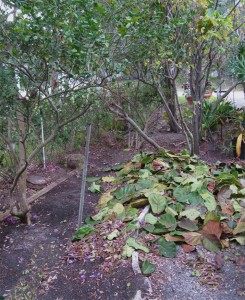
Cleanup all leaves from the base of your plants Every 10 days or so apply Liquid Seaweed. You can find this product at most local plant nurseries or order online. I found it at Landmark Nursery in Tarpon Springs (853 East Lake Rd. S. just north of Keystone Rd) and Wilcox Nursery in Largo (12501 Indian Rocks Road).
- Liquid Seaweed stimulates beneficial soil microbe activity which leads to improvement in plants natural resistance to stresses such as the recent freeze.
Step Three- Creative camouflaging, inter-plant fast growing plants
The most effective way to transform leafless areas is to poke live stuff in between the dead stuff. You will soon get over sad ugly crispy bushes, concentrating on fast growing ornamentals. I recently lost three trees in my back yard, but ended up with enough sun to plant veggies. Initially, I fretted about losing my tree canopy and most of my Bromeliads (mosquito-breeding-centers). But in the end, the changes brought new opportunities.
Surely, there are things you always wanted to try to grow! Now is the time to add veggies or annuals, the weather is perfect. Consider planting:
- Add ornamental veggies (collards, kale, red cabbage, brussels sprouts, broccoli, etc…) in between your leafless shrubs. Not only do we have a beautiful garden to look at, we always have vegetables for dinner. Our backyard now features all types of cabbages which are camouflaging our denuded Ixoras.
- Plants are not cheap, so to extent your budget start seeds. I have put in Zinnias, Marigolds, Cosmos, many types of Cabbage, Kale, Kohlrabi, Broccoli, Artichokes, Peas, Beans, Okra, Squash, Lettuce, Tomatoes, Mustard Greens, Arugula, Spinach,Cilantro, Basil and Dill.
- A tip to get your sees to germinate more rapidly– soak them in Liquid Seaweed. Research shows not only will you hasten germination but you will have larger root mass, stronger plant growth and higher survival rate.
Step Four- Some damage can be undone.
Act now to revive your plants before they are tested by the rain we are getting now, which could lead to mold, mildew and eventual rot.
Annuals and Shrubs- First employ Step Two above- Water and Snacks
Then:
- Spray plant(s) with an Organic Fungicide (available at Home Depot, Lowe’s or local nurseries). Avoid Synthetic Fungicides, they are extremely caustic.
Cold sensitive palms have taken a real hit. Even if all the fronds are brown, you have a chance of saving your palm by following this protocol:
- Clear leaves and mulch away from your palms base.
- Lightly cultivate around the palm to make a little moat.
- Water deeply.
- Top dress the moat with Mushroom Compost (the only local source I have found is Lowe’s and some specialty nurseries).
Every 10 days add the following into the middle of the fronds where the new bud will be developing
- Liquid Seaweed
- Chelated Palm Nutritional
- Liquid Copper Fungicide
Note: I could only find the Chelated Palm Nutritional at Home Depot, the other two items above you will most likely have to buy from an independent local nursery or on-line.
Step Five- Replace with better choices, planted in better spots
- Consider if the plants you are replacing are not only cold sensitive but wind resistant.
- Replace some of your dead non-native exotics with native specimens which are much more tolerant of the cold.
- Plant more trees. A tree canopy give lots of protection from Florida’s extremes- hot and cold.
- I really like a lot of the cold-sensitive tropicals, but I don’t plant them in the front of my house where they are exposed to the damaging effects of the north wind. Plant cold-sensitive specimens on the south side of your house, blocked from the north wind.

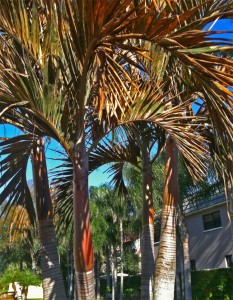
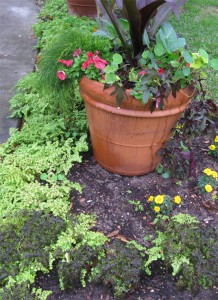
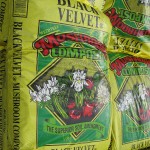
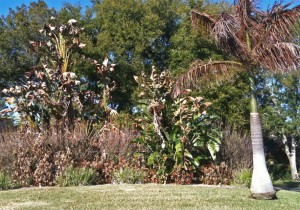
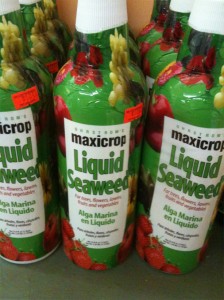
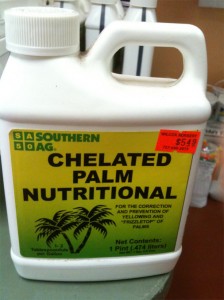
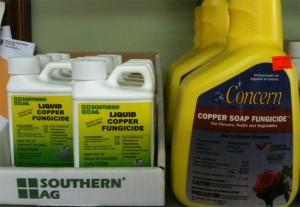
Thanks for this great information. I knew I shouldn’t cut away the dead yet, but my “babies” are hurting!! Just like when we were sick as kids and Mom gave us crackers and gingerale. I will look for the seaweed and fungicide. They sound like good things to have on hand anyway.
Thanks for the comprehensive overview,
helped me to not follow my gut and prune,
I can wait,
you are doing a wonderful job of informing!
A few cautions about copper fungicide:
– the spray might stain concrete, patios and pavers.
– apply only to palms, it is not intended for other shrubs or plants.